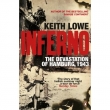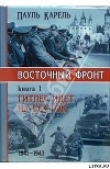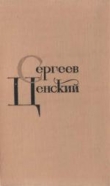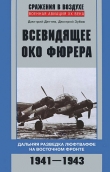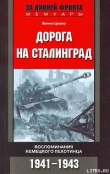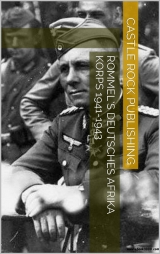
Текст книги "Rommel's Deutsches Afrika Korps 1941-1943"
Автор книги: Автор Неизвестен
Жанры:
История
,сообщить о нарушении
Текущая страница: 4 (всего у книги 19 страниц)
In the event only the main column came into action and when the attack opened on 30 March, it ran up against strong British defences manned by 3rd Armoured Brigade lying behind extensive mine-fields and supported by an aggressive Royal Air Force, which attacked and delayed the German advance. Not until the second day of the offensive, and in daytime temperatures of over 80°F, did the infantry and the panzer regiment, supported by 8.8cm guns firing over open sight and with Stukas dive-bombing ahead of them, break through and by pursuing the British closely allow them no time to form fresh defence lines. The southern column, meanwhile, had failed to reach the battlefield at all due to a combination of navigational errors and bad going.
The results of this minor affair were all positive: the British had been driven from the last good position blocking the south-western passage into Cyrenaica, German troops had proved themselves capable of fighting a desert campaign, and 8th Army was not as strong as Italian intelligence officers had believed it to be. Rommel began to consider whether he might not open an offensive, using the forces at his disposal rather than wait until the panzer division arrived from Germany. He knew that to carry out this scheme would flout the authority of his Italian superior, that he would be acting without Hitler's consent or knowledge, and that he would be ignoring the advance of OKH. He made the decision and ordered 5th Light Division to resume the advance upon Agedabia. On 2 April it drove up the Via Balbia, in a compact group with the reconnaissance battalion in the van followed by the machine gun battalion. The panzers were out guarding the flanks and from horizon to horizon the sky was filled with pillars of dust as the vehicles ploughed their way forward. British artillery fire forced the reconnaissance unit to deploy and to take up battle formation but no sooner had the unit shaken itself out for battle than the rearguard withdrew – a wearying tactic whicr^the British used throughout the morning. Tanks from 8th Army were reported to be in position south east of Agedabia and Streich commanding 5th Light ordered the panzer regiment, the anti-tank detachment, and the machine gun battalion to move east of the road. The machine gunners began to move into position but were halted south of the town. Rommel, up with the forward troops in his usual fashion, swung the reconnaissance battalion round the left flank; a move which brought it floundering in a salt marsh. The panzer regiment then struck at the British forces, feinting and withdrawing, and enticing the British armour on to the screen of 8.8 cm guns which stood waiting. The 5th Royal Tank Regiment, true to cavalry tradition, charged the enemy and were brought under fire by the 8.8s at almost point blank range. Twenty-five of the British vehicles lay broken or burning in front of the gun line and then the 2nd Battalion of 5th Panzer Regiment swung back and drove the RTR, off the field and pursued them northwards. Meanwhile the Tower Hamlets Rifles, a London territorial unit, had come under attack and had lost a company. Only another tank charge brought the hard pressed British infantry relief from the German panzers.
This pressure against the British southern flank reacted upon the stubborn defence which was being put up against the machine gun battalion on the central sector. Thus, by midday the machine gunners had advanced across an area dotted with the palls of black and acrid smoke rising from tanks which 5th Panzer Regiment had 'brewed up' and vast clouds hanging in the sky above depots which 8th Army had destroyed before their withdrawal.
The reconnaissance battalion having dragged itself from the salt marsh pushed on to the town and joined forces with the machine gun battalion. Their combined strength brought the advance across the Tripoli-Cyrenaica frontier and onward to Zuetina. Nightfall brought a halt to the fighting and the divisional units, having laagered, made preparations to maintain the advance during the following day and to pursue closely the enemy who was withdrawing upon Benghasi. Rommel's firm order was to keep contact with the British forces. They must not be allowed to shake off the German advanced units. During the night the Italian divisions and the Santa Maria detachment closed up on the German spearhead. .
The battle was proceeding to that date in the manner in which Rommel had planned that it should go. The Agedabia wells had been taken, the way into Cyrenaica was open, and air reconnaissance as well as ground observation indicated that the British were abandoning the province in some disorder and were withdrawing upon Benghasi leaving behind them huge masses of stores. The immediate threat to Tripoli had been averted and the objective which OKH had hoped might be accomplished during May was in German hands by April.
It was on the battlefield at Agedabia that Rommel decided upon his next and very controversial move. He realised that it was useless to drive the British before the German armour; the 8th Army must be smashed in open battle. It will be seen from the map which appears on page 80 that, starting at El Agheila, Cyrenaica projects as a huge bulge, the Bight of Bomba, into the Mediterranean and that the Via Balbia follows this coastline. Rommel reasoned that the British retreat would be by road and, if this were so, then a swift advance along native tracks and via Msus and Mechili to Derna, that is across the chord of the bulge, would bring his forces to the eastern border of Cyrenaica behind the British and thus cut them off from their bases. He expressed this intention to his allies and to his staff; most of them were horrified for he was suggesting that a major military grouping of limited desert experience should cross a 400-mile expanse of waterless desert. The Italians said that such an operation was out of the question. [4]

It required months of preparation; the danger that columns might become separated and lost in the almost trackless expanse was too great and, in any case, the sand seas and the mountainous djebel were both impassable. Rommel who had personally reconnoitred the routes from the air declared them to be passable. In any case the British had traversed the desert and what they could do the Axis troops could also accomplish. His own quartermaster's department pointed out that there would be problems with both water and fuel and that tyres would be cut to shreds in the rough, cross-country going. Rommel proposed the most draconian measures to overcome the fuel and water crises. The forward movement of all German and Italian fighting units was halted. Every available truck which could be taken, commandeered, or requisitioned was assembled and soon there was a lorried force of more than 800 vehicles.
Each lorry was to ferry fuel and water to the front line troops and when sufficient had been brought forward the trucks would be prepared for the trans-desert trip. With the fighting column's lorries would be 6 days fuel, 5 days water ration, 5 days food including two days hard tack, and only sufficient ammunition for one day's battle, for it was not considered that there would be any fighting during the approach march to Derna. In the supply columns whatever was the lorry's normal load would be halved and the balance made up of petrol. Rommel's intention was that his whole force would be a self-contained combat group. Within two days the whole scheme had been worked out and the fuel supplies had been brought forward. The great desert trek could begin. The battle plan was straightforward. There were to be several columns. Those of the left flank – a German reconnaissance battalion and Brescia Division – who were to hold the British and slow down the pace of their withdrawal, were to advance along the Via Balbia and go on to capture Benghasi. This column would then divide and the main body would thrust towards the strategically important cross-roads at Mechili, while the second and weaker column from Brescia Division would continue up the road exerting pressure upon the British before going on to capture Derna.

All the trans-desert columns were to head, by various tracks, towards Mechili. One of the major columns would be divided to form a pincer movement aimed at the objective. One main group would form the outer left wing and 2nd Machine Gun Battalion, forming the inner wing of these two columns, was to advance to Solluch at which point a column of empty oil drums pointed due east marking the desert track to the objective and along which the machine gunners were to advance. The main, southern pincer led by the commander of 5th Light Division, was to move towards Mechili along the Trigh el Abd. This column was headed by 8th Machine Gun Battalion and followed by an anti-tank company, a panzer company, the Italian Santa Maria detachment, a motor cycle company, and a motorised artillery battalion from Ariete Division. Rommel's intention was two-fold: he was trying to create the impression that the Axis forces were stronger than in fact they were and, that the German objective was a tactical one – Benghasi – and not a strategic one, the destruction of 8th Army's field force. [5]
A report written after the operation and dealing with the column of soft-skinned vehicles which followed the machine gun battalion is revealing for the details it gives of the difficulties of desert driving. As the convoys of trucks headed across the desert in pursuit of the tank columns, pillars of dust rose high into the air and obscured the column. Shrouded by the thick blanket of hot dust and with the vision impaired even more by the khamsin which was blowing, drivers moved their trucks out of line to avoid the dust of the main in front. Thus the convoy extended in width as the drivers moved almost in line abreast and the dust cloud which hung above it stretched for miles, giving the appearance of a whole armoured division on the move. Daylight navigation was by compass for no reliance could be placed on the Italian maps which had inaccuracies up to 20 miles. The most prized possession was a set of British maps which were not only accurately marked but also showed such vital information as whether the going was good or bad.
Radiators boiled as the trucks struggled up the steep slopes of the djebel, a high stony escarpment, and during the following day the going worsened as the column struggled forwards through seas of loose sand which bogged down the vehicles. That day, 4 April, was a day of despair at the slow going but three broken down tanks, abandoned en route were put into running order and taken on strength. The column commander drove through a fierce sandstorm which had halted his group and reached Mechili where he reported the arrival of his convoy. By evening the trucks had rolled in and a petrol point had been set up. There was sufficient food, water, and ammunition; only lack of petrol, the life blood of panzer operations, had caused some worry.
Meanwhile the divisional commander's column was still struggling towards Mechili. It had been delayed by adverse conditions – bad going, sand storms, and seas of shifting sand – and did not reach the objective until the morning of the 5 April.
Mechili was a trigh cross-roads settlement in which 8th Army had set up a dump and a strong point into which had been brought 3rd Indian Lorried Brigade. This unit had orders to halt the German advance upon Msus and presently added to its strength was the headquarters of 2nd Armoured Division, 'M' Battery Royal Horse Artillery, 3rd Australian Anti-tank Regiment, and a small number of miscellaneous units. These had fled into the box for the protection of the major units. On the German side there was anxiety in the columns pressing towards the place for they were running low on fuel. Rommel had to seize Mechili before he could swing his Corps northwards to Derna and ordered that the objective be seized without delay. He had flown over his columns following their progress through the desert and landing where necessary to give them detailed orders. Other Fieseler Storch aeroplanes from the command went out to locate and to direct the widespread columns on to their target. During the night, guided by Verey pistol flares, by searchlights shone into the air, and by a number of similar devices the Panzer company was brought up to Mechili.
The most northerly column of the trans-desert group was made up of the panzer regiment (minus the company with the southern column), a motorised artillery battalion, the anti-tank companies, and parts of Ariete Division. At Bir e! Gerrari the column turned on to the Benghasi-Mechili track but as a result of map error found that it was confronted by an impassable salt lake. Confusion piled upon confusion as the original error was compounded by poor navigation and, as a result of this, the whole column drove round in wide circles for some time and then ran out of fuel leaving the panzer regiment stranded in the desert.
On the Via Balbia the reconnaissance battalion fighting against Australian infantry and artillery rearguards captured Benghasi in the bright moonlit pre-dawn of 4 April. The town and its airfield were handed over to the advanced guard of Brescia Division and the battalion then swung towards Mechili to add strength to the panzer ring which was beginning to surround the 'box' there. Other small units which had been separated from the columns came in and Rommel led in 8th Machine Gun Battalion and then directed it to advance upon Derna and to cut the Via Balbia. Parts of the British force encircled at Mechili were ordered to break out towards Derna and by unlucky fate they encountered the machine gun battalion also heading for that town who flung them back into the Mechili box. But there were other delays to the machine gun battalion advance particularly around the Derna airfield and not until the reconnaissance battalion arrived during 7 April, to reinforce the attack and to bring it forward again, was it possible to cut the road. The town and the aerodrome fell quickly and more than 1000 prisoners were taken including two generals, Neame and O'Connor, and much equipment including several tanks.
The 8th Army reacted and established a series of blocking points. At nightfall on 7 April the 9th Australian Division supported % tanks had taken up position astride and thus blocking the Via Balbia. The Australian left flank was at Acroma, a town 15 miles west of Tobruk, and there was a small British force garrisoning the important box at El Adem to the south of the town.
The fighting around Mechili rose to a climax. Even though the Panzer regiment from the northern column was still stranded for lack of fuel other units of other columns had arrived to strengthen the encircling forces. During the night of 7/8 April the main attack went in. The Santa Maria detachment stormed from the east, the machine gun battalion from the north, and a group of 10 tanks of the southern column drove up to strike at the southern side of the box. Part of the British garrison thrust along the western track mounted on vehicles and armoured cars, but this escape attempt was brought under fire and was turned back by anti-tank guns and the machine guns of an Italian motor cycle company. Isolated small groups of British soldiers, which then struck to the south-east, broke through the ring but the main garrison stood fast and fought it out. The British and the Imperial troops battled on until the panzer company broke into the box and beat down all resistance. Five generals were among the prisoners but of more use to the Germans were the supplies and fuel which they seized, for these enabled their drive to continue. The 2000 prisoners brought problems for the northern column had still not arrived in force and the remaining German troops were thin on the ground. Not until the evening of the 8th had sufficient forces been gathered to renew the advance northwards to reach the coastal road and by the time that the Axis troops arrived at Tmimi the British had already evacuated it. The advanced guard of Brescia Division, whose task it had been to hold the British while the outflanking movement was carried out, had failed in this and did not arrive at the objective until 8 April.
With the seizure of Tmimi the province of Cyrenaica had been recaptured, the British had been thrown back, some of their principal commanders captured, and their armour beaten in battle. But the Australian Division had withdrawn in good order towards Tobruk and thus, although the Axis forces had gained a tactical victory, they had not defeated the British in the field.
There were other gains both in strategy and morale. Strategically the British Army fighting in Greece was no.w aware that its rear communications were threatened by the German victory in the desert. In the matter of morale Axis prestige rose, not only in the Arab countries but also among the people of Italy and in the Italian Army, for that force began to regain much of the confidence which it had lost as a result of earlier defeats.
All this had been accomplished with only a small loss of men and, although the fall-out of armoured vehicles was quite considerable, due to the long and exhausting march through the desert, the German recovery service was able to return most tanks to their units. Losses in soft-skinned trucks were made good from stocks captured from the British.
The greatest praise must go to Rommel for his incredible ability, energy, and resource. He seemed to be at every part of the front, leading an attack here, guiding a column there, and it was due to his fierce drive that the offensive succeeded. He was now supremely confident. He had grasped the secrets and the tactics of desert warfare. Not only did he have the measure of the terrain but also that of his enemies. Now with adequate supplies he could advance and he made no secret of the fact that he planned the final objective to be the Suez canal.
On 9 April orders were issued to continue the pursuit of the British towards Tobruk with all possible speed, and 5th Light Division, with the reconnaissance battalion in the van, stormed eastwards leaving the Italians to carry out security duties around Mechili.
Tobruk – First Attack
With the first offensive concluded Rommel considered his next move and saw that this must be the capture of the port, fortress, and fleet base of Tobruk into the protection of which a great part of the hard hit but undefeated mass of the British desert force was undoubtedly moving.
There were only two alternatives. Either he could obey the orders of his superiors and go over to the defensive along the eastern borders of Cyrenaica, there to await the arrival of the main of his
Army before undertaking further operations, or he could continue his pursuit of the British enemy in the hope of bringing them to battle and of defeating them in the field before undertaking the advance into Egypt. Rommel considered the alternatives and the factors which would affect his decision and then came down on the side of the offensive. He would pursue the British and in a race to Tobruk might either enter the town and seize it from its weak garrison or enter it simultaneously with the British and in the resulting confusion .capture the place. But if he was to act offensively then he must act quickly and obtain men for this operation.
The mass of 5th Light Division was widespread across the desert's dusty face and some of its units were still lying stranded for lack of fuel in the desert south-west of Mechili. The Italian divisions had not yet caught up and, of 15th Panzer, only the motor cycle battalion and the anti-tank battalion were on their way to the front while the main of that division was still unloading at Tripoli.
With the decision to pursue the offensive, orders went out and behind a German advanced guard the main of Brescia Division left Derna on 8 April in an advance upon, and with the intention of, capturing Tobruk. Behind this advanced group the rest of 5th Light followed and then, in succession, the Ariete Division and those elements of 15th Panzer which had been able to join the column. By 9 April Gazala had been reached although strong British rearguards had frequently caused the column to halt, to deploy, and to take up attack positions. The advance continued all through the day and by evening had reached the 'White House', some 25 miles west of Tobruk. By now the pattern of life which the desert compelled upon those who lived in it had established itself. The interval between daylight and complete darkness in this climate is a very short one. Combat operations in the desert were usually halted, therefore, some time before the onset of darkness so that the troops could be fed, the vehicles serviced, defence positions allotted, and preparations for the morrow put in hand.

Those hours of darkness between the night of 9 and 10 April, had been used by the British to concentrate their forces on the approaches to Tobruk so that the German advance during the morning of 10th met determined and increasing resistance which brought it to a halt about 14 miles west of the town. Rommel, up with the forward troops and determined not to allow the tempo of the advance to falter, ordered the leading elements of Brescia Division into an infantry assault to clear the road but the attack failed in the heavy defensive fire which crashed down upon the two Italian battalions. During this unsuccessful assault the remainder of Brescia had closed up and Rommel, who had ordered the attack to be resumed on 11th, cancelled this when he realised through a personal reconnaissance how strong the British defences were around the town. Brescia then took up investment positions along the western front of the fortress between the coast and the high ground south of the road.
It was quite clear that until his reconnaissance Rommel had had no idea of how strong Tobruk really was and he seems not to have considered that the British would have improved upon the Italian fortifications and converted the town into a first-class defensive position. The British would find the supply problem less difficult to resolve for the Royal Navy controlled the seas, and the reinforcement and adequate provisioning and equipping of their troops in Tobruk could be carried out without too much interference from the Luftwaffe.
Tobruk had been designed by the Italians to be held by a garrison of divisional size but the population had risen to more than 36,000. It must be stated that more than two-thirds of that number were made up of non-combatant Corps and army troops, Arab refugees and prisoners of war. The actual fighting strength was between 10,000 and 12,000 battle-hardened veteran soldiers who were determined to hold out and to conduct an aggressive defence.
The physical defences of the town were two perimeters each defended by a belt of barbed wire and an anti-tank ditch. The confidence of the past months had allowed gaps in the wire and the ditches to remain open and therefore vulnerable although Australian infantry battalions had undertaken the task of preparing the defence and repairing the evidences of past neglect. The outer defensive belt extended nearly 30 miles across from west to east and nearly 9 miles inland from the sea. A douple row of strong points were set within the perimeter, laid out like a chess board and capable of giving mutual supporting fire. Most of these strong points had been prepared for infantry garrisons armed with machine guns and light anti-tank weapons. They were usually concreted with covered communication trenches and were hard to detect for they were not pill boxes standing upon the ground but sangars lying on, or just below, the surface.
The inner defence line was a small version of the outer and within the inner perimeter there were five miniature fortresses. The whole area was extensively mined and to aid the defence there was an airfield.
The battles to capture Tobruk fall into three phases. There were the reconnaissance probes on the 11 and 12 April, followed by the attacks from the southern front on 13th and 14th, and then from the south west on 16th and 17th.
When Rommel became aware of the strength of the place he realised that his troops helter-skeltering towards the town might dash themselves against the fortress and be destroyed piecemeal. He determined to throw an iron ring around the town quickly and intercepted the reconnaissance battalion and the anti-tank battalion as they headed eastwards. He switched them southwards and ordered them to pass round the British positions and to try to find a weak spot on the flanks. East of Acroma, artillery fire and extensive barbed wire defences brought the advance by the German troops to a halt. Rommel then gave orders to General Streich to swing further south and to advance upon El Adem. At that point there was a road up which his forces could drive and thereby enter Tobruk from the south. Streich pivoted his troops behind Brescia and moved to carry out his orders but sand storms and the usual inaccurate maps, together with poor navigation, so delayed his advance that he did not reach his objective until 11th. Local successes were scored against British patrols throughout the day but the main intent – to advance up the southern road – failed and the newly arrived panzer regiment, which then tried to force a passage on 12th, was brought to a halt by gun fire and an anti-tank ditch.
The first of the phases of the battle of Tobruk had opened. Rommel next changed the direction of his attack and flung a machine gun battalion to the east of Tobruk but that assault, too, failed in the face of heavy and accurate artillery fire which the defenders summoned up to defeat the Axis assault.
German troops had now thrown a cordon around the town and, although they were still too weak to carry out a major assault, it was felt that they had sufficient strength to defeat any break-out attempt by the garrison. The danger lay more in an offensive to raise the siege which British forces outside Tobruk might make.
The 8th Army had a screen of weak but mobile columns operating around, or holding certain strategic areas to the east of Tobruk, notably at Halfaya Pass, Sollum, Bardia, and Sidi Barani. This open eastern flank now became Rommel's immediate worry for it was from the east, along the Via Balbia and the desert tracks that the Matildas and the other British armoured fighting vehicles would storm in a massive counter-offensive. It was important that, even if the Axis forces did not have the strength to defeat an all-out blow, the British advance should be obstructed for as long as possible and their movements impeded. To achieve this it was essential to seize and to hold the ground running south from Bardia to the Halfaya Pass. If this area could be secured then the British forces attempting to move westwards could not use the Via Balbia but would be condemned to a wide and fuel-consuming drive via Sidi Omar. Such a deflection would not only break up their concentrations and betray the direction and strength of their thrust, but also allow time to prepare against it.
In order to know the significance of this eastern sector its topography must be understood. From the town of Sollum an escarpment, generally impassable to vehicles and difficult even for infantry, runs inland on a south-east line for about 50 miles. Only at Sollum and at Halfaya, 8 miles to the south-east of that place, were there passes permitting the escarpment to be crossed without difficulty and it was for the possession of those passes that the battles of the eastern flank were to be fought.
So that the reader is not confused with the fighting which then went on at the western flank around Tobruk and that which was conducted on the eastern front around Halfaya, this latter will be recounted separately, for the battles were, in a sense, only the seizure and consolidation of an outpost and, in that sense, a subsidiary to the main effort which was being made around Tobruk.
Rommel then removed from his beleaguring army a small detachment and sent this in a thrust to the Egyptian frontier with orders to take the vital positions in the Sollum—Halfaya area. The battle group was to act as a blocking force and as an outpost,from which would come early warning of any relief operation against Tobruk. On 13 April, the specially reinforced 15th Motor Cycle Battalion and 3rd Reconnaissance Battalion reached the frontier and went on to capture Bardia, Fort Capuzzo, and Sollum from the weak British garrison which then withdrew into Egypt. But 8th Army still held Halfaya Pass and the Germans, too few in numbers to force the issue, made no serious effort to take the pass but contented themselves with consolidating the gains which they had made. On the following day, the 15th Panzer Division was entrusted with control of operations along the frontier and took command of all Axis troops in the area, for now one of Trento Division's motorised battalions, Montemurro, had been brought forward and placed in reserve.
Weak British counter-attacks to capture the lost ground were launched on 15 April and during the following days they became more frequent, larger in number, and more difficult to beat back. The Axis forces were hard pressed and were being forced back under pressure from British armour and infantry, from the Royal Air Force which attacked their positions with low level machine gun attacks and high level bombing, and from the Royal Navy which took part in the operation by sending a monitor to bombard the positions in Sollum. But then on 17th came reinforcements with the arrival of a mixed flak battalion whose two light and three heavy batteries were soon in action against British tanks. Stukas of the Luftwaffe, sent into aid the embattled ground forces, dive-bombed and sank the monitor. Rommel was determined that the eastern enclave would hold.


